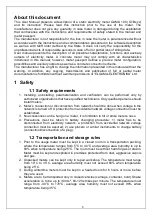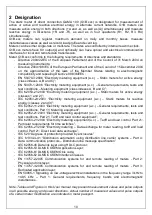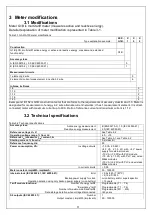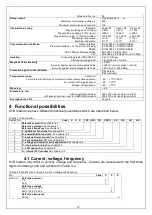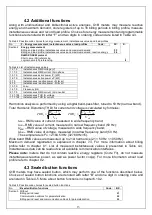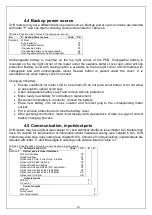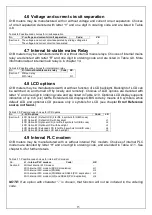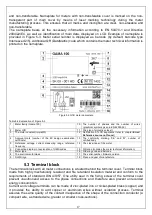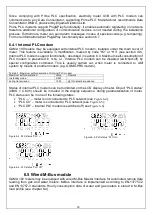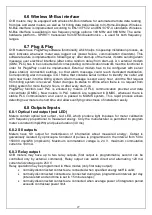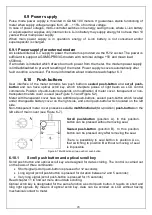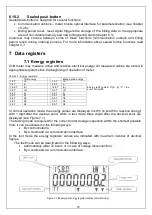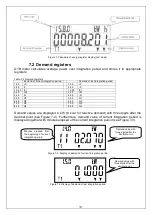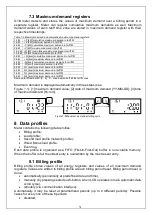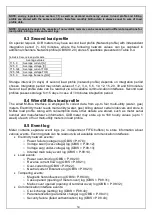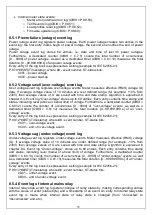
22
While network voltage is disconnected, micro-controller operates in energy saving mode, thus,
indicator is not active. When G1B meter is disconnected, data still may be reviewed by affecting
optical scroll key by long light signal or by pushing a scroll push button for 2 to 5 seconds. For
more information see chapter 11.1.
*- The OBject Identification System (OBIS) defines the identification codes (ID-codes) for commonly used data items in
electricity metering equipment. OBIS provides a unique identifier for all data within the metering equipment, including
not only measurement values, but also abstract values used for configuration or obtaining information about the
behaviour of the metering equipment (IEC 62056-61 Electricity metering – Data exchange for meter reading, tariff and
load control – Part 61: Object identification system (OBIS)).
5.6 Internal clock
Meter contains internal clock of real time, which counts years, months, weekdays, hours, minutes
and seconds. Clock information is used to change energy and maximum demand tariffs to form
demand intervals and to register events with date and time stamp. Clock is stabilized by quartz
resonator. Temperature drift is compensated by software (only when network voltage supplies
meter).
Table 3-2 presents the main clock characteristics. Clock can be automatically adjusted to daylight
saving changes. There are different ways to define time and date of daylight saving changes. They
are listed in Table 5-3.
Table 5-3 Possible clock adjustments
Date format
[MMDD.hh]
Date and time of clock adjustment
0000.00
No adjustment for daylight saving changes
MM00.00
Clock is adjusted for summer time on the last Sunday of a month MM at 2 a.m. by winding the clock 1 hour
forward;
Clock is adjusted for standard time on the last Sunday of a certain month MM at 3 a.m. by winding the clock 1
hour backward;
MM00.hh
Clock is adjusted for summer time on the last Sunday of a specified month on the time specified by winding the
clock 1 hour forward;
Clock is adjusted for standard time on the last Sunday of a specified month on the time specified by winding the
clock 1 hour backward;
MMDD.hh
Clock is adjusted for summer time on the time and date specified by winding the clock 1 hour forward;
Clock is adjusted for standard time on the time and date specified by winding the clock 1 hour backward;
5.6.1 Synchronization of internal clock (RTC)
In G1B meters it is possible to synchronize internal clock of the meter. There are two concepts in
G1B meter – clock synchronization and clock setting. Clock synchronization is considered when
clock adjustment value is less than ±9 seconds. If meter receives clock synchronization command
with <±9s, then internal clock is adjusted with corresponding value and this event is not recorded
in event logs nor in load profile. Otherwise, when meter receives clock synchronization command
with >±9s value, such event is considered as clock setting and meter adjusts internal clock with
corresponding value and this event is recorded into event log and an entry is made in load profile
with corresponding status byte. Maximum value of clock synchronization command can be ±60s.
There are some security measures implemented in G1B meters in order to prevent attempts of
corrupting the measurements of the meter. There are no limitations of how many clock
synchronization commands could be send to the meter within a day, but there is a limitation, than
single clock synchronization command can be accepted within integration period and a total
correction value cannot exceed ±600s over single year. If there are several attempts of
synchronizing the meter during single integration period or total synchronization value exceeds
±600s, then meter will ignore this command and no clock adjustments will be made (return error
message). Time synchronization can be carried out via all available communication interfaces.
Summary of Contents for G1B Series
Page 2: ......

